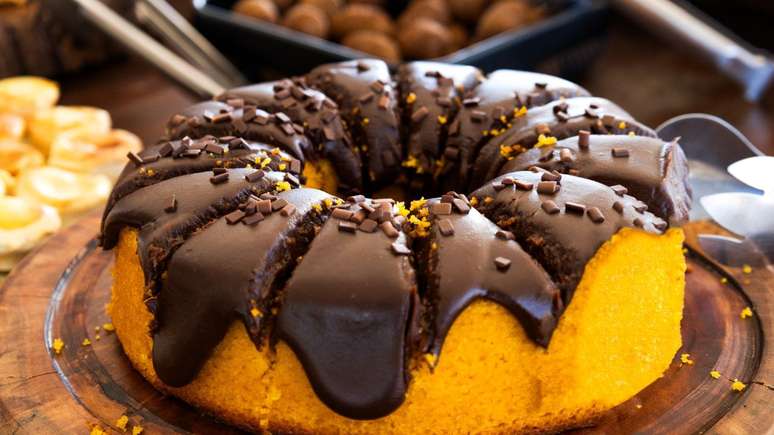With holes or without holes, chef Heloisa Bacellar reveals her secrets for making the perfect pudding, soft and with a golden caramel; watch
Perhaps it is difficult to find a Brazilian who does not have fond memories of pudding. The candy is famous all over the world, but here in Brazil it has a special preparation that requires only three ingredients: egg, condensed milk and milk. And, because he is the darling of Brazil, the date of May 22 is his, National Pudding Day.
To celebrate and dispel once and for all the doubts about the preparation, we called the chef Heloisa Bacellar, of ‘Na Cozinha da Helô’, who revealed all the secrets to making a perfect pudding, with or without holes. Write them all down or save this article somewhere on your phone so you can always check it when you’re making pudding.
Does the pudding mold need to be buttered?
The first step in making a delicious pudding is caramel, and one of the doubts that arises is: can the pudding mold be greased? Chef Helô Bacellar makes it clear that no. “Actually, quite the opposite, since we’re going to caramelize the mold. The safest thing is to do it in a separate saucepan, and then pour that caramel,” he points out.
Even the caramel in the pudding has a precise point: «It must be very golden, but it can’t be too little, because in this way it doesn’t change, nor too much, because it becomes bitter».
Pudding with holes vs. pudding without holes
The base of the pudding is extremely simple, according to Bacellar, just beat it in a blender or in a bowl with a whisk. However, for those who are or are not fans of holes, this step will give you the desired finish. “Bubbles are bits of air buildup in the pudding cream, so if you want a smooth, creamy pudding, run the blender for a few seconds to mix the ingredients well, and let it sit until the top foam disappears. Pudding with holes , whisk a lot; the more you shake, the more balls there are, the more foam it forms and the more holes your pudding will have,” she explains.
How you heat the cream also determines the result. “If you cook the pudding at about 180°C in the oven or with very high heat in a bain-marie, your pudding will rise, puff up and boil faster, consequently it will have more holes. If it is soft, you must cook it on very low heat, or cook it at lowest possible that your oven can reach in the oven, around 160°C”, he clarifies.
Is there a difference between making pudding in the oven and on the stove?
Chef Bacellar says there are three ways to make pudding, but water and a bain-marie must always be present, because it can’t be cooked directly over a fire. The first option is the oven, in which the mold with the cream and caramel goes inside another mold with water; the second is the cooker, in which the shape with the contents goes inside a larger pot with water. The third, the cook who always discovers new techniques, tells us:
“About 4 years ago, I did a project on pudding and decided to test new methods, one of which is the pressure cooker, which is impressive, because it greatly reduces the cooking time. The only impasse is to find a way that it fits and that it stays with a couple of fingers of water, other than that, it’s very interesting.
When the pan begins to sizzle, you count 10 minutes for a pudding without holes – and 13 for one with holes – then turn off the heat, leave the pan closed until it stops sizzling and open without resistance. From the moment it boils, it will take about 45 minutes.”
What is aluminum foil in pudding for?
The expert says that the function of aluminum foil in the pudding is divided into one that is extremely important and another for the taste of the customer. “There are people who really don’t like that coat which is kind of like cream, harder on top of the pudding, and then, if you use aluminum foil in the oven, you’ll avoid this film on top and your pudding will get too clearer,” he begins.
“With the pudding on the stove – in the pressure cooker as well as in the regular one – the aluminum foil is crucial, as it protects the candy from any water splashes. , it can flood your pudding. In the pressure cooker, this is still more dangerous, so I tie the aluminum foil with string just in case,” he concludes.
How to know the point of the pudding?
Chef Helô Bacellar jokes, “with a pressure cooker it brings luck, right? You have to respect the time”, but guarantees that he can understand what the purpose of bain-marie pudding is in the other alternatives.
“In a regular pan and oven, you know it’s firm when you touch it with your fingertips, even if it shakes (sic) and you know it’s golden brown, but the color can be deceiving, so you can’t” trust the 100%. If you stick a toothpick or the tip of a very thin knife into the center and pull it out, it will come out clean, not gooey with cream,” she says.
Despite the good tips, he has one in particular that guarantees: «The pudding detaches and almost detaches from the side, despite the caramel which gives it a little stickiness, you can see that the cream moves away from the edges».
How long do you have to leave the pudding in the fridge?
“Pudding is not something we have to make and eat three hours later, on the contrary, the ideal is to prepare it the day before or even two days before. After resting in the fridge, it will be much tastier and creamier”, the explanation begins.
And since the dessert is made with milk and eggs, you can’t put the pudding in the fridge while it’s still hot. “The right thing is to take the pudding off the heat or oven so it comes to room temperature. The next step is to cover it with new aluminum foil and take it to the fridge.
And many ask me if they can put the pudding in the freezer, and no, the right thing is to let the pudding rest for at least three hours in the fridge before removing it from the mold to serve it, but this is the bare minimum. Because, if you leave it the day before or even two days before, it will be much firmer and tastier. The pudding lasts for three days, so it’s good, indeed, even a little longer, ”he clarifies.
The pudding broke, now what?
And finally, Heloisa Bacellar asks you not to worry if the pudding is broken: “I always say that if the pudding falls apart, be patient, the important thing is that it tastes good, because it can be fixed. Serve in bowls with a simple syrup like that, and it still looks nice. Also because, who hasn’t broken a pudding?”
Source: Terra
Ben Stock is a lifestyle journalist and author at Gossipify. He writes about topics such as health, wellness, travel, food and home decor. He provides practical advice and inspiration to improve well-being, keeps readers up to date with latest lifestyle news and trends, known for his engaging writing style, in-depth analysis and unique perspectives.







-qxtvxp3fmib9.png)
